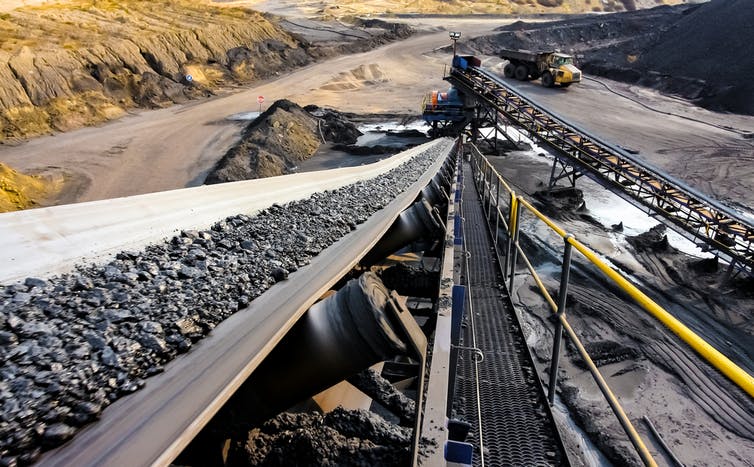Huibrecht Margaretha (Breggie) van der Poll, University of South Africa
The South African coal mining industry has a long history, dating back to the late 19th century, and contributes significantly to the economy. The coal sector employs 92,230 people and annual earnings are R27.9 billion (about US$2 billion). But the industry is causing severe environmental challenges.
For example, Emalahleni, a city in the country’s Mpumalanga province, has been exposed for over a century to the continuous mining of coal. It is experiencing the sterilisation of land due to underground fires, water pollution, surface collapse, and acidification of topsoil.
Communities in the vicinity of a mine can experience severe health challenges and might even have to be relocated.
Read more:
Air pollution, temperature and respiratory disease: a South African study
South Africa has environmental and other regulations which mining companies must comply with. The King IV report provides background to how companies can operate regarding the economy, environment and society. The Carbon Tax Act and the National Environmental Management Act 107 of 1998 are fairly stringent. But the industry still produces acid mine drainage and other waste as part of its daily activities. This has to be managed.
Environmental management has scientific and engineering aspects, of course, but there are also accounting practices which could support greener mining. Management accountants can reduce the environmental footprint of companies while keeping them profitable, by decreasing costs and waste. The original purpose of environmental management accounting was to provide information for internal use. But it can be included in a company’s financial statements and other annual reports for external stakeholders to make informed decisions.
Read more:
The case for turning South Africa’s coal fields into a renewable energy hub
We have been working on a framework that would guide management accountants in making decisions about these environmental issues. First we came up with a set of propositions about mining and its environmental impacts. Then we surveyed coal mining practitioners to get their views on the propositions.
We found that most of them were unfamiliar with environmental management accounting concepts. They saw various laws as punitive rather than helping to balance company profit and environmental concerns. They also indicated that our new framework would need to emphasise risk management in guiding the decisions of coal mines.
Environmental management accounting practices
Environmental management accounting practices are tools that can be used to identify, analyse, manage and reduce environmental costs. They can identify occurrences and activities in mining processes where waste production can be reduced, resulting in cost-cutting opportunities.
These practices include material flow cost accounting, activity-based costing and life cycle costing. The first looks at the flows of materials, energy and water. The second identifies activities that drive costs, those that don’t add value (if the activity is not necessary in the process) and can be reduced. Life cycle costing considers the costs of all activities at the mine from the day it starts operating until the mine closes. It even includes activities after closure if something happens at the mining site that needs to be handled to reduce its environmental footprint.
Read more:
How South Africa’s rural communities are getting a raw deal from mining
To refine our decision-making framework, we interviewed supervisors, senior managers, general managers, chief executive officers and employees of different mining companies. We wanted to know what kind of information they felt they needed to make decisions on environmental impacts. We also held a focus group to identify associations between the different information components of the framework.
We found that only 27% of the interviewees were familiar with the concept of environmental management accounting.
But all the focus group participants agreed that reduced water pollution, improved health, and improved costing and decision-making would benefit investors, coal mining employees and the natural environment. They agreed that environmental management accounting would add value for all these stakeholders by providing useful information.
In 2019 a study comparing Australia and Sri Lanka showed that environmental management accounting was gaining traction in various companies. The study showed that professional accounting bodies should incorporate it into training programmes to meet industry requirements. They also made the point that this approach to accounting as the basis for decision-making brings new challenges. For example, accountants have to work closely with other departments to track materials and processes.
Our study showed that more training is needed in South Africa. From the interviews it became clear that there is a need for the harmonisation of production and environmental management activities.
Read more:
Climate change: ditch 90% of world’s coal and 60% of oil and gas to limit warming to 1.5°C – experts
Our work showed the value of green industrialisation. We hope that more executives with decision-making powers will use the tools of environmental management accounting in future. More case studies in the South African coalmining industry would help to enhance the framework and determine its industrial scalability.![]()
Huibrecht Margaretha (Breggie) van der Poll, Professor of Management Accounting, University of South Africa
This article is republished from The Conversation under a Creative Commons license. Read the original article.

